Listings
Listings Insights
Listings Insights is a revamped, redesigned home for the metrics and performance insights previously found in Search Tracker.
Insights displays where locations rank in local search for keyword searches and how they stack up against competition. View detailed reports of these metrics in the Visibility tab, or use the Map to see location insights geographically.
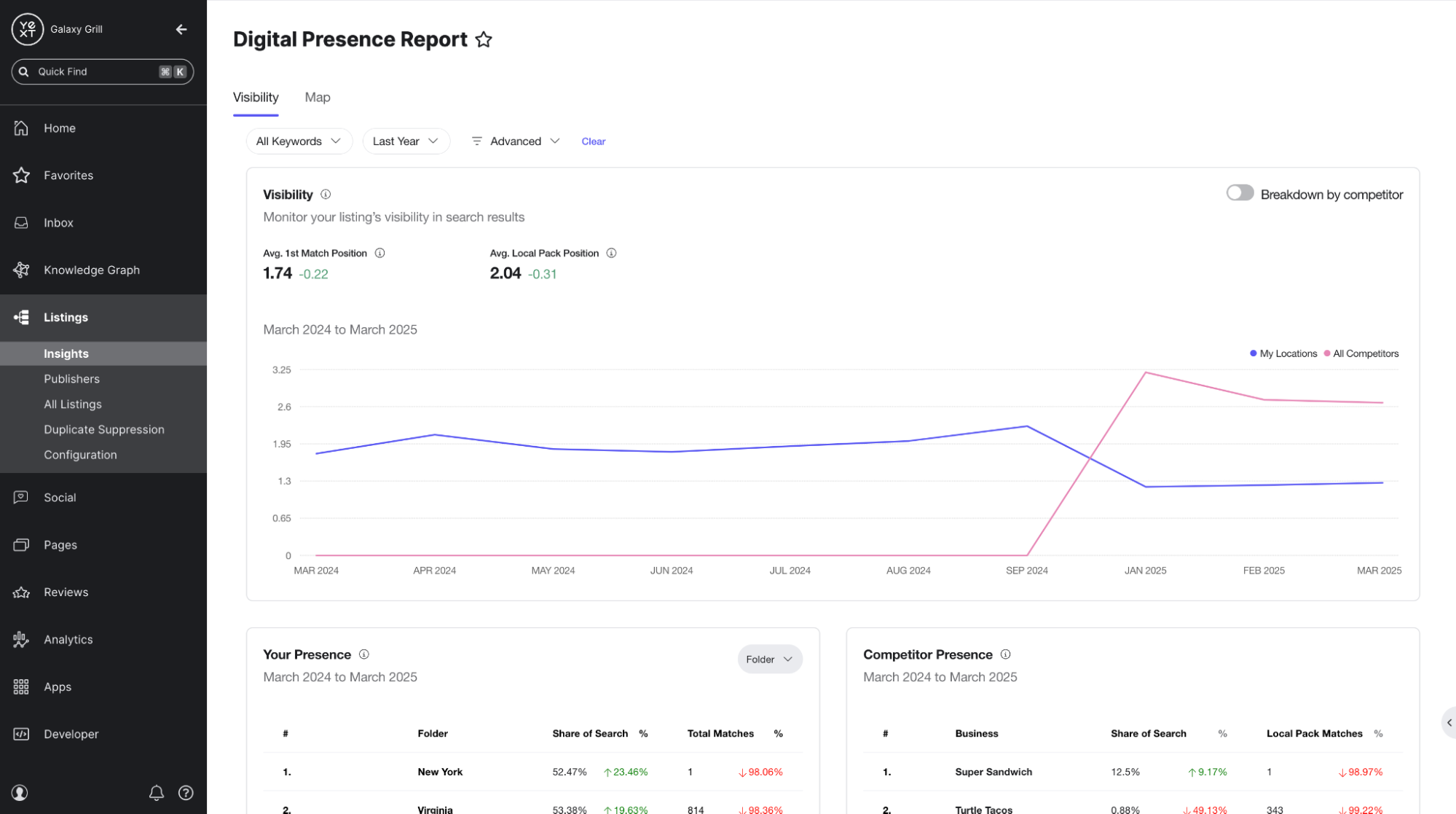
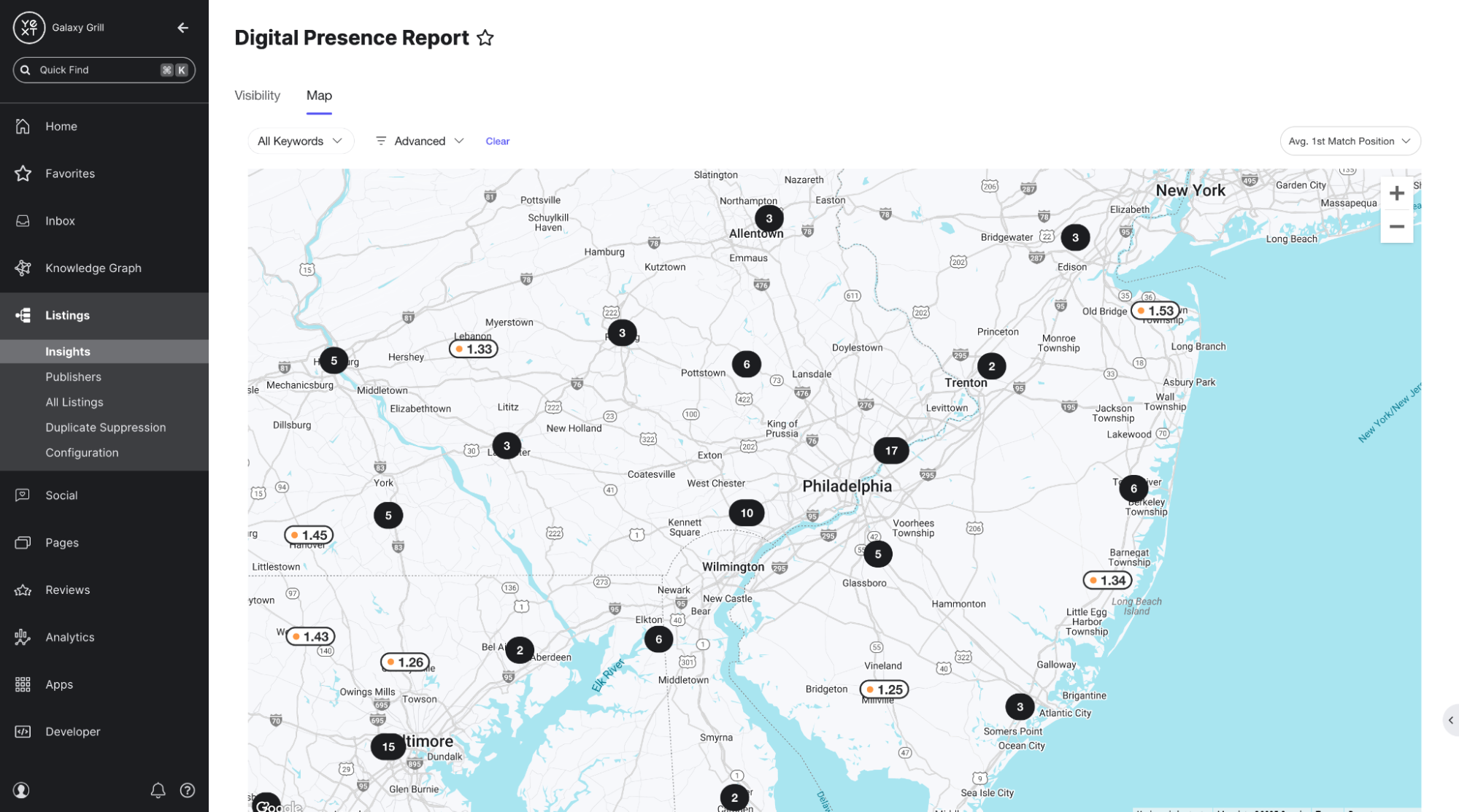
Listings Insights includes an interactive view to provide deeper performance insights into Search Tracker metrics over time, with comparisons across locations, regions, or folder structures.
Listings Insights is available to all clients with Competitive Intelligence or Ultimate subscriptions. To learn more about these subscriptions, reach out to your Yext account team. For more information on Search Tracker and the Listings Insights page, see the Search Tracker guide and the Listings Insights training module.
Listings Recommendations Updates
We’ve released new ways to view and interact with Listings Recommendations in bulk. Users will now see a banner on the All Listings page to view their active recommendations. Click the banner to review recommendations in one place and bulk-edit entities to make content changes, all from the new Recommendations page.
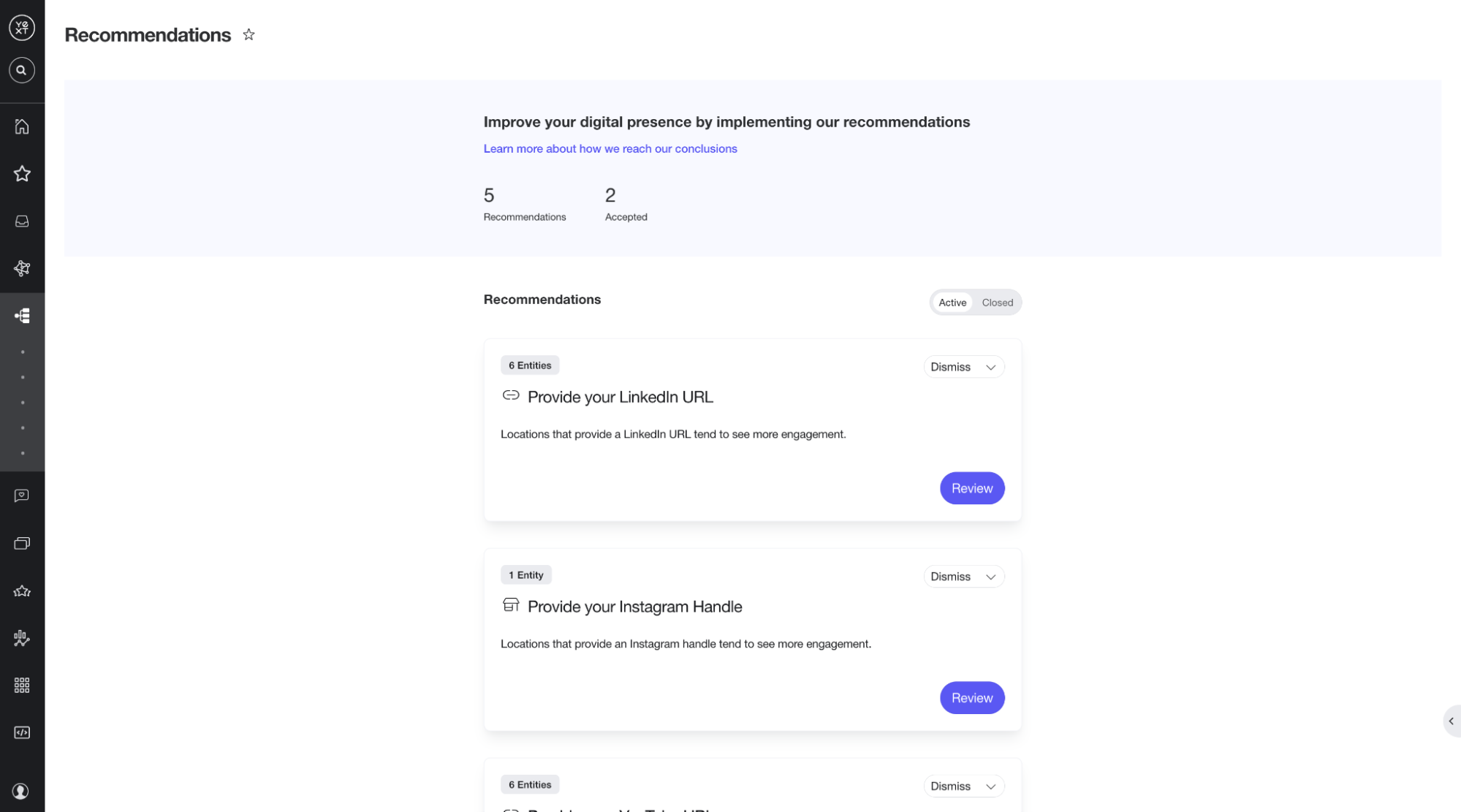
The Recommendations page is available for all Listings clients now. For more on using Listings Recommendations, see the View and Manage Listings Recommendations help article.
Featured Message Clicks Metric Removed from UI and API
As announced in the Fall 2023 release, the Featured Message Clicks metric was deprecated as of December 13, 2023. Work has now been completed to remove Featured Message Clicks from the Report Builder and the Reports API. For more information, see the Google Metrics Updates reference and the API Changelog.
Location Scan Mobile App Deprecation
The Location Scan mobile app was removed from the Apple App Store and Google Play Store in November 2023. As of this release, the app is no longer supported.
[Resellers] Listing Scan Update for GDPR
Resellers using the Listings Scan tool will now only be able to access data for scans completed within the last three months. In order to maintain compliance with GDPR, data from scans completed more than three months ago will no longer be viewable. For more information on how resellers can leverage the Listing Scan, see the Use the Listing Scan resource on the Help Center.
Publishers
Updated Apple Attribute Logic
We have updated our logic for sending attributes to Apple. If an attribute is selected, we will send a true value to Apple. If an attribute is marked as “No” then we will send a false value. Previously, if an attribute was set to “No”, nothing was sent to Apple.
For example, if you select “Yes” for Wi-Fi then “Wi-Fi” will appear as an amenity on the listing. If you select "No" or leave that attribute blank, then “Wi-Fi” will not appear on the listing.
This new logic allows us to remove unwanted attributes that are coming from other sources outside of Yext.
New Apple Brand and Location Naming Requirements
Apple has updated the requirements for Brand and Location naming. The names of Brands and their respective Locations within an Apple Business Connect Account must match identically. Apple will only accept unique names for locations within specific business categories.
These requirements will go into effect in mid-April. In the coming weeks, we will be notifying brands that are impacted and providing documentation on how to make these updates.
WhatsApp Link for Google Messaging
We have added a new field to the Knowledge Graph called Google Messaging (googleMessaging). This allows us to send your WhatsApp and SMS data to Google to be displayed on your listing.

When a WhatsApp URL is added to this field, a link will be added to your listing.
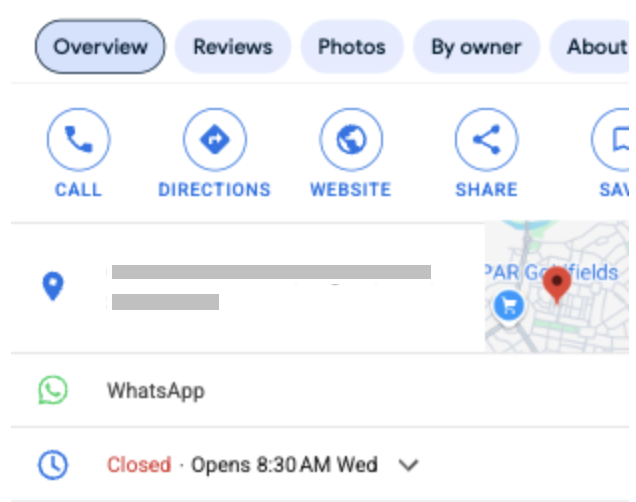
However, if you include data for both SMS and WhatsApp, only the SMS option will be displayed. You will also see an error message noting this if you have both filled out in Yext.
Built-In Open Date Field for Google
A new built-in Open Date field for Google has been added to the Knowledge Graph. Previously, the Open Date field needed to be set up as a custom field.

If you are already utilizing the custom field, we will still send this data to Google, and no additional action is needed. However, for any new updates, we recommend using the built-in field. If both the custom field and built-in field are added to an entity, we will send the built-in field to Google.
Quinceanera.com Deprecation
Quinceanera.com has been removed from the Yext Publisher Network. This means that we will no longer sync data to this site.
Reviews & User-Generated Content
Additional Review Generation Publishers
Review generation is now available for additional publishers, including:
- Indeed
- Glassdoor
- Healthgrades
- Doordash
- Apple App Store
- Google Play Store
Review Generation View Invites Updates
We’ve added the following filters on the Review Generation View Invites page: Sent Date, Reviewed Date, and Status.
Check out the Review Generation Metrics unit to learn more.
Review Generation Template Updates
We have made many improvements to Review Generation templates to enhance the user experience:
- You can now specify a specific publisher to send a review to (instead of using the review balancing algorithm). When editing a template, you’ll see this in the list of available fields: Publisher Review Submission Page:
{{tag.review_submission_url_PUBLISHER}}. To link to a specific publisher, replace 'PUBLISHER' in the parameter with the publisher's API name (e.g.,{{tag.review_submission_url_googlemybusiness}}for Google). - We have created a new built-in template to showcase this new parameter, with links to Google, Facebook, and First-Party.
- We now support query parameters in the LeaveFeedback app when redirecting to first-party reviews from review invitations. This means the page to leave a first-party review can be prepopulated with query parameters such as the rating the user clicks on in their review invitation and their first name and last name, if you choose to customize the logic of your invitation template.
- Custom fields are now embedded in templates using their API name instead of their internal Yext ID, making it easier to edit templates. You’ll see these updated in the list of Available Fields when you edit templates. This also allows Resellers to inherit templates that embed custom fields.
- We now support WebP images in review invitations.
Check out the Review Generation Templates unit to learn more.
QR Codes
You can now generate and download QR code image URLs for review invitation links. QR codes allow users to display review invitation links in stores or on receipts, allowing customers to generate more reviews without a contact list or creating an integration.
To download QR codes, navigate to Reviews > Generation > Send Invites and click on Download QR Codes. From here, you can choose the entities you want QR codes for and whether the QR codes will use the review balancing algorithm or be publisher-specific. Download the QR codes as a CSV and share them with location managers.
QR code downloads are only available to download in the platform and are not accessible via API.
To learn more, check out the Sending Review Generation Invitations unit.
Social
Direct Messages
We have added the ability to view and respond to direct messages on Facebook and Instagram via the Social UI or API.
To review direct messages, navigate to Social > Comments & DMs. From this screen, you can toggle the view to see Comments or Direct Messages. When you select a direct message from the list on the left, you will be able to review the message thread. You can also send a text response by typing in the text box or applying an asset.
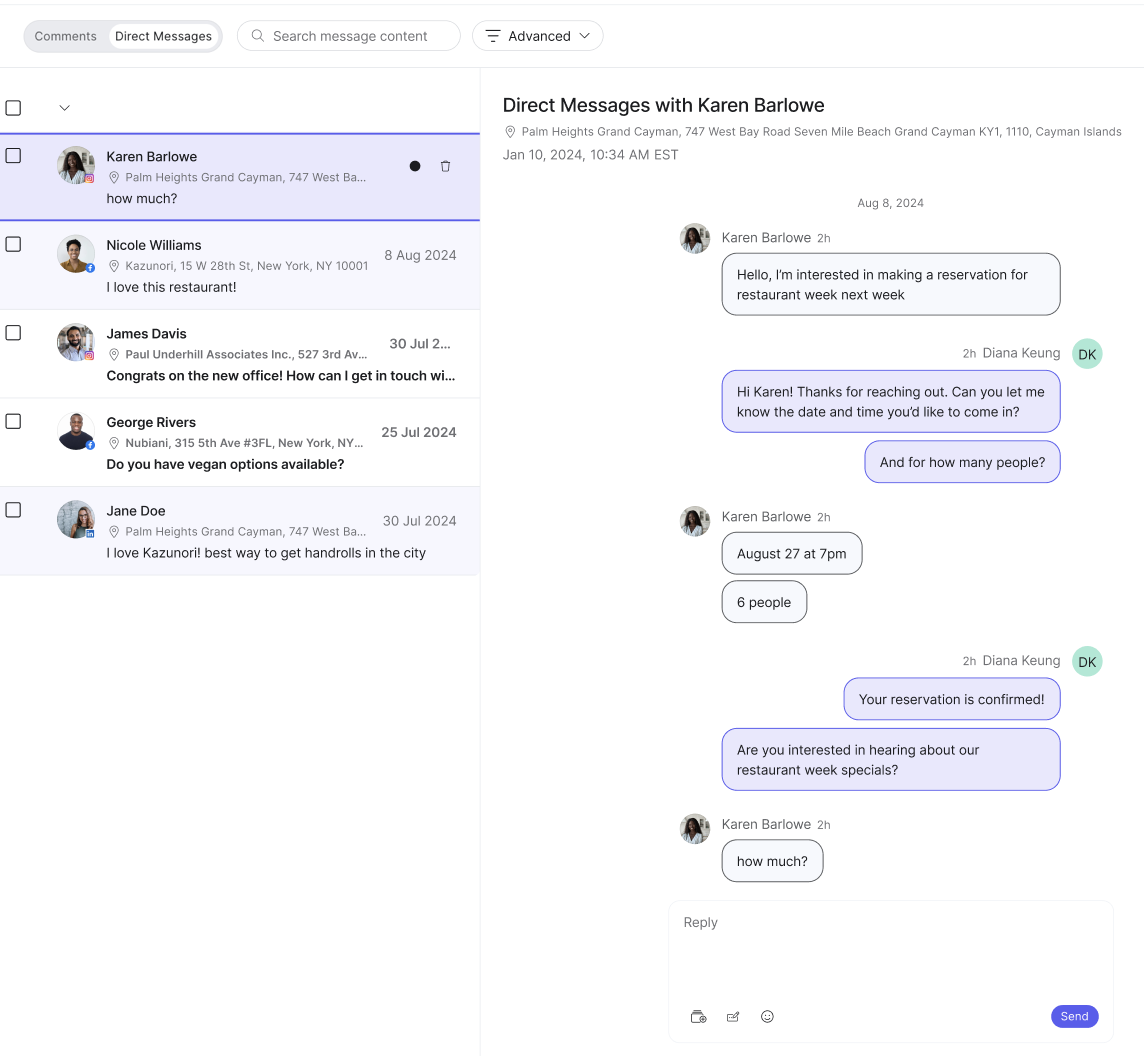
This feature is available as part of Yext Social.
Review the Direct Messages documentation to learn more.
Recommended Post Times
When creating social posts for Facebook, you can now schedule them to go out at the recommended times to drive more engagement. Recommended Times refers to the times of day that our performance model predicts will generate the highest number of impressions and engagement for your posts.
We built a performance prediction model that considers factors such as post length, post sentiment, readability, post frequency, and industry trends to determine the time of day per individual location selected that will maximize engagement.
To utilize this feature, begin by creating a post and make sure to select Facebook as one of your networks. Once you have selected your networks and the publish date, you can toggle the Use Recommended Times setting to On.
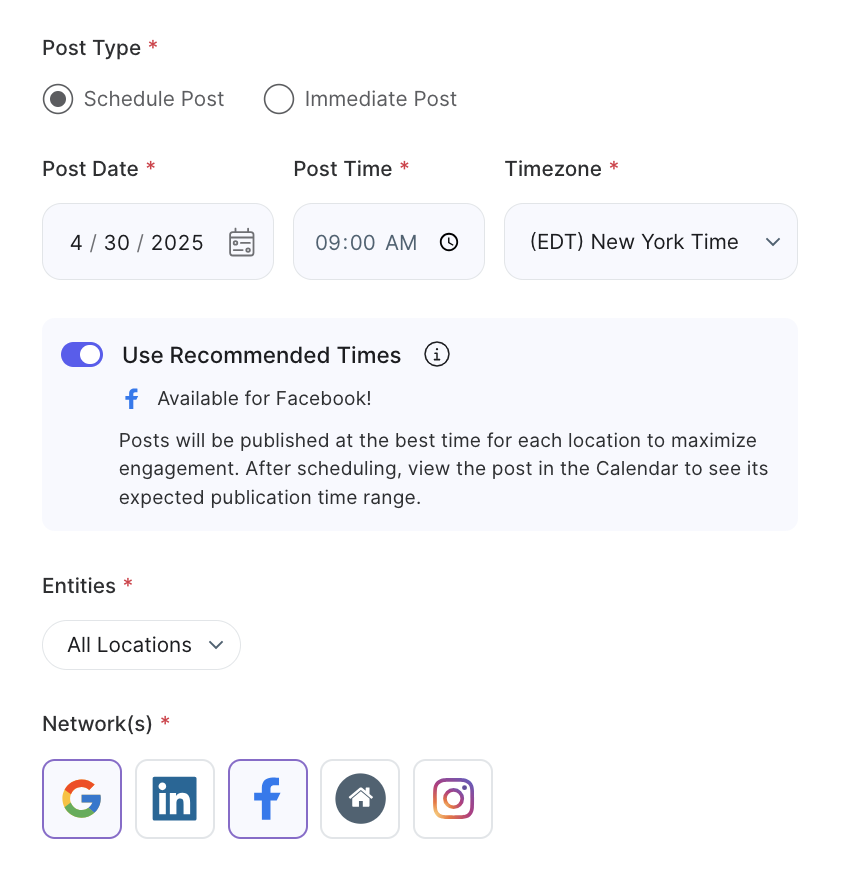
This update is currently only available for Facebook. Posts to other networks will still go out at the scheduled time that you set.
This feature is available as part of Yext Social and is only available via the UI.
Review the Create and Edit a Post documentation to learn more.
Deprecated Social Metrics
Some Social metrics have been deprecated as part of this release.
In the February release, we announced the deprecation of the legacy Post Count metric. As of this release, we will no longer update new data for this metric. However, you will be able to view historical data. You can instead use the new Post Count metric.
Facebook will deprecate the Instagram Page Total Impressions metric on April 24, 2025. As of that date, data will no longer be pulled for this metric. However, you will still be able to view historical data. We recommend using the Instagram Page Total Reach metric to review unique impressions in reporting.
Knowledge Graph (formerly known as Content)
[Announcement] Headshot Field Behavior
We’re announcing an upcoming change for the May 2025 release to adjust the behavior of photos uploaded to the Headshot field in the Knowledge Graph.
Currently, the Headshot field treats photo aspect ratios differently, depending on whether a photo is added directly through the Knowledge Graph UI or uploaded via Connectors or the API.
Photos added to the Headshot field via the Knowledge Graph UI (via Entity Edit or File Upload) have no enforced aspect ratio. Today, photos uploaded to the Headshot field via Connectors or API are automatically padded to fit a 1:1 aspect ratio (i.e., if the image received is a 2:3 aspect ratio, this results in additional whitespace above and below the image).
To make Headshot photo behavior more consistent, all photos uploaded to the Headshot field will be stored as-is. Any photos added to the Headshot field via Connectors or API will no longer be automatically padded. This update will not affect any photos already stored in the Headshot field, but will apply to any connector runs or updates made via API after the May release.
Any updates to photos in the Headshot field will be visible via Entity History. This update does not require any user action, and will take place for all users as of the next release on May 14, 2025.
Export Display Name of Linked Entities
We’ve added the ability to export the display name (the Name field) of linked entities when performing an entity export. Previously, only the Yext ID and Entity ID of linked entities could be included in an export.
This feature is available now in the Knowledge Graph. For more information on exporting entity data, see the Export Entities help article.
Geocode Support for Service Areas
Many clients want to reflect both their in-person and virtual service offerings in Yext. With this release, Yext now supports geocodes based on service areas in addition to addresses. This “hybrid locator” model allows users to display both physical locations and remote agents that serve a designated service area on a map.
To utilize service area geocodes, users can now customize their own entity types to use only the built-in Service Area field, omitting the built-in Address field used for brick and mortar locations. Users can then define multiple service areas for a single entity without having to specify a single address, and these service areas will be geocoded in Yext to appear as pins on a map.
The service area geocode functionality is available now in the Knowledge Graph for all clients using entity types with a Service Area field, but no Address field. For more information, see the Leverage Geocodes for Service Area-Only Entity Types guide.
Connectors
Apply Linked Acount App
The Apply Linked Account connector app enables users to apply linked publisher accounts to a set of entities. This app requires an API key with read/write permissions on the Entities API, an entity template with the desired value in the Linked Accounts field, and a saved filter containing the set of entities.
The Apply Linked Account connector app is available in the App Directory now for all users.
Hearsay Yext Integration App
The Hearsay Yext Integration connector app is available in the App Directory now for all users. Customers of both Hearsay and Yext can use this connector app to easily sync data between the Yext Knowledge Graph and Hearsay Workspaces for specific fields. For more information, see the Hearsay release notes.
Platform
Login Page Updates
We have made some minor design changes to the login page, making it more user-friendly. Most notably, we added a link so you can easily access the Hearsay login page.
Analytics
Search Tracker Moving to Listings Insights
Search Tracker is moving to the new Listings Insights page featured in this release. All functionality will be rolled into Listings Insights, and clicking Search Tracker in the Yext platform navigation will redirect to Listings Insights. For more information, see the Listings Insights release item.
Search
Generative Answers
Generative Answers are AI-generated summaries of search results displayed at the top of the page. Generative Answers synthesizes information from different top search results to help users quickly find relevant information without having to sift through multiple results, improving efficiency and reducing friction in the search experience.
Generative answers are only available with the Advanced search tier.
You can start testing Generative Answers in your search configuration by enabling it in the UI with one click. Navigate to Search > [Your Search Experience] > Generative Answers and click the toggle to Enable Generative Answers. Save, and then you can start testing it in Test Search. Check out the Generative Answers unit to learn more about the backend configuration and optional properties.
To add generative answers in the Hitchhiker Theme, you must be on Theme 1.35 or above. Once you upgrade your theme, add the GenerativeDirectAnswer component to each universal or vertical search you’d like to have generative answers. See the Hitchhikers Theme Changelog for complete upgrade instructions and the Generative Answers (Frontend) unit for more information.
To add generative answers in Search UI React, use the <GenerativeDirectAnswer /> component. See the GenerativeDirectAnswer React component doc for more information.
Bucketed Relevance Sorting Algorithm
We are releasing a new relevance sorting algorithm to induce more ties between results, allowing multiple sorting algorithms to be applied for better search results. The new bucketed relevance sorting algorithm groups results into buckets based on their relevance score. Secondary sorts will then be applied within each bucket.
We recommend using the buckets algorithm when a vertical has multiple sorting options applied and uses relevance as the primary sort option. Bucketed relevance can only be used as the primary sort.
For more details on sorting, check out the Sorting and Dynamic Reranking unit.
Apps
New Connector Apps: Apply Linked Account and Hearsay Yext Integration
The Apply Linked Account and Hearsay Yext Integration connector apps are available now in the App Directory. For more information, see the Apply Linked Account Connector App and Hearsay Yext Integration release items.